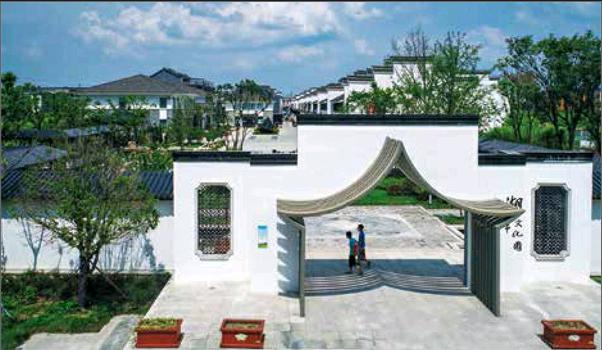南浔湖笔小镇:千年文宝一脉承
2017-11-06孟琳
孟琳



湖笔与徽墨、宣纸、端砚并称为“文房四宝”,是中华文明光辉灿烂的重要象征之一。湖州市南浔区善琏镇是典型的江南小镇,因产湖笔而闻名,“中国湖笔之都”享誉中外,其湖笔制作技艺已入选国家非物质文化遗产名录。善琏小桥流水、石砌河岸,尽显水乡风韵,这里几乎是家家出笔工,人人会制笔……
蒙恬造笔传千年
毛笔起源甚早,历史上有蒙恬造笔之说。相传当年秦朝著名将领蒙恬将军跟随秦始皇东巡经过善琏,与当地女子卜香莲相恋。后蒙恬曾居湖州善琏改良毛笔,“用枯木为管,鹿毛为柱,羊毛为被(外衣)”,采兔羊之毫,“纳颖于管”,制成后人所称之“湖笔”。夫妻俩共同制笔,将技艺传给善琏百姓,于是善琏世代以制笔为业,奉蒙恬为“笔祖”。当地几乎家家出笔工,户户会制笔。
湖笔被誉为“笔中之冠”,而它真正蜚声四海,是从元代开始的。
元代以前,我国以宣笔最为有名。南宋时期,湖州是士大夫们栖隐山林的首选之地,他们及附庸文士们书风的流变和泼洒写意的文人画影响了毛笔的笔料由以兔毫为主转向以羊毫为主。
元代,宣笔逐渐式微,湖笔取而代之。湖州制笔能工冯应科、沈日新、温生、杨显均、陆颖等十余人留名史卷。据《湖州府志》记载:“笔,名品,最多出归安善琏村。相传元时冯应科、陆文宝善制笔,其乡专习而精之,故湖笔名于世。”
“湖州冯笔妙无伦,还有能工沈日新。倘遇玉堂挥翰手,不嫌索价如珍珠。”当时人们愿以千金重价求买湖笔,足见其声誉卓著。
离人文胜地苏杭都不远的善琏,享有得天独厚的地理优势,无论取杭嘉湖一带的山羊毛做笔尖,还是用余杭一带的山竹做笔杆,都很便捷,且质量有保证。当时在湖州有不少文人墨客都特别钟意字画,包括大书法家赵孟在内喜欢执手湖笔挥斥方遒,也进一步完善了湖笔工艺,使得它更适合书写、绘画。
明成祖朱棣迁都北京,文化中心北移。湖笔工匠们驾一叶扁舟,入京售笔。当时主修《永乐大典》的解缙等人,对陆颖、陆文宝、徐原珪、施廷用等人的佳制激赏不已,纷纷赋诗作文加以咏赞。其后,善琏笔工便逐渐散布于大江南北,“湖笔”之名,世代不易。
对有关文献记载进行粗略统计,先后开肆外埠的湖笔名店计有:北京戴月轩、贺莲青、李玉田;上海杨振华、李鼎和、周虎臣、茅春堂;苏州贝松泉;扬州兴散寺;天津虞永和等。
经过近千年的延续,湖笔逐渐成为善琏小镇的支柱产业。镇上几乎家家户户都做毛笔,大都是家庭小作坊的生产类型,女做笔头,男修笔。
善琏是个小镇,大量的湖笔都是依靠笔庄销售。解放前,在全国各大城市都有善琏人经营的笔庄,依靠这些笔庄建立的商业网络,湖笔的销售范围慢慢扩大,影响也越来越大。
千万毛中拣一毫
明代谢在杭在《西吴枝乘》一书中称赞湖笔“毛颖之技甲天下”,这也是对湖笔制作技艺最高的赞誉。
湖笔又称“湖颖”,这也是它的最大特点。所谓“颖”,就是指笔头尖端有一段整齐而透明的锋颖,业内人称之为“黑子”。“黑子”的深浅,就是锋颖的长短,是用上等山羊毛经过浸、拔、并、梳、连、合等近百道工序精心制成。
湖笔选料严格,传统上只择取杭嘉湖一带所产的优质山羊毛,因为这一带山羊在冬季吃含高蛋白的桑叶,锋嫩质净。山羊毛选用的是颈、腋下不易与外部磨擦的部位的毛,所取毫料须陈宿多晒,除去污垢,再浸于水中分类组合。
一头健壮的山羊身上有三两笔料,有锋颖的只有六钱。一支湖笔,笔头上的每一根具有锋颖的毛都是从无数粗细、长短、软硬、曲直、圆扁的羊毛中挑选出来的,拣毛工人能把笔料按照等级分出“细光锋”“粗光锋”“黄尖锋”“白尖锋”等40多个品种,分别用在不同笔上。每个品种之下再分出若干小类,其精细程度,丝毫不亚于绣花。白居易就曾以“千万毛中拣一毫”和“毫虽轻,功甚重”来形容制笔技艺的精细和复杂,这一说法绝非夸张。
提起湖笔的制作工艺,就不得不去善琏湖笔厂转转。沿着镇上的古街往南走,到尽头看到一个古色古香的牌楼,便是善琏湖笔厂。
湖笔厂的原址是当地人纪念蒙恬的蒙公祠。1956年4月,当地办起善琏湖笔生产合作社,1959年创建善琏湖笔厂。走进厂区,院子里有一尊双羊的雕塑,原型就是善琏湖笔厂的双羊商标,这也成为上乘湖笔的标志。
如今的善琏湖笔厂,除了生产湖笔外,更成为一个湖笔展示区——各个工作环节都有明确的分区,引导参观者了解从笔料区分、笔头制作、装套、择笔到刻字等主要环节。
出身湖笔世家的善琏湖笔厂厂长马志良说道:“制笔是一件非常枯燥又严格的活,做笔的人每天守着自己的一道工序,一干就是一辈子。”
湖笔在千百年的传承中始终保存着传统手工制作技艺。一支湖笔,要经过笔料、水盆、结头、蒲墩、装套、镶嵌、择笔、刻字等八大步骤128道工序才能完成,各部分都要求精工细作,制笔师傅一坐往往就是一整天。
“择笔”是湖笔制作工艺中非常关键的一环。看一支毛笔好坏,关键就是看毛笔的“锋颖”。笔工凭借眼力精挑细选,剔除杂毛,在善琏湖笔厂的择笔车间,一个个水盆前,笔工们靠着一把小刀,將毛一根一根地梳理开来,放在接头管上,把折毛、病毛、无锋的毛都剔除。对半成品杂毛的剔除,保留整齐的“锋颖”,做到“光、白、严、直”四大要求,才能称得上是一支好湖笔。这样的笔头富有弹性又不会分散开叉,书写起来才会行云流水,得心应手。
善琏湖笔的制作工艺,一直是以“家庭传承”“师徒传承”的方式沿袭。每一种湖笔从原料、造型到做法,经过老师傅们世世代代传授,早就已经固定下来,形成精细而熟练的工序分工。
善琏湖笔厂的制笔师傅制笔工龄平均有30年。许学建从20岁开始拜师择笔,40年来,他右手握拣笔刀的大拇指上生了厚厚一层老茧。许师傅刀工快、准,笔头中每一根杂毛都逃不过他的眼睛,即便如此,每完成一道工序他都会仔细检查。正是这样的匠心,才让湖笔制作工艺这个有两百多年历史的非物质文化遗产在时光的打磨下,依旧熠熠生辉。endprint

湖筆文化产业园。
“一部书画史,半部在湖州”。文房四宝之首的湖笔,还积淀着千百年制笔业与书画史的文化传承。
湖笔盛名历经千百年而不衰,历代书画家功不可没。湖州才子迭出、文风不绝。著名书法家王羲之、王献之、颜真卿、米芾、苏轼、王十朋等都曾为官或寓居湖州,更有曹不兴、张僧繇、贝义渊、朱审、释高闲、徐表仁、燕文贵等湖籍书画俊才。他们的书画活动,带动了湖州制笔业的兴起。
从湖笔成名始,历代笔工都十分注重与知名文人、书画家的联络沟通,一则得以吸纳真言改良笔品,二则可借显达文人的举荐而扩大影响。

湖笔文化馆里的蒙恬和卜。争莲铜像。
元末湖州文人沈梦麟有诗云:“吴兴阁老松雪翁,书画直与钟王同。当时笔家争效技,陆颖一出超群工。”笔工们知道若能得到赵孟的垂青,则必会声名鹊起而沽得善价,于是纷纷向赵孟提供制作精良的毛笔。据《紫桃轩又缀》记载,赵孟将笔头中最好的精豪取出收藏,令湖笔之名不胫而走。
据《湖州府志》记载:“冯应科,归安人,善制笔,妙绝天下,时人称赵子昂字、钱舜举画、冯应科笔为吴兴三绝。”可见,在元代,笔工甚至可以和当时顶尖的书画大家齐名。
到了近代,文学家郭沫若同湖笔结下了不解之缘。他对狼毫作柱,羊毫作被的“白云笔”颇为喜爱,曾赋诗赞湖笔。
善琏制笔能人辈出,一个小镇与书画界的亲密关系,就这样在日久经年的交往中养成了。直到现在,善琏镇著名的湖笔一条街上,多数笔庄经营者仍旧保持与书画家的密切联系。四德笔房的庄主慎鹤云对笔者说:我与湖笔结缘30多年,接待了数不清的书画家,他们从各地慕名而来,就为看一眼湖笔的制作过程。
慎鹤云虽不会写毛笔字,却能精准地分辨出各种类型的毛笔分别适应的字体。慎鹤云有几个相熟的书法家朋友,每年都会来家中小住,试笔,作画。一来二去,熟悉了会留下一些墨宝。因而,慎鹤云笔房里的收藏不乏名家之作。
“湖笔文化要想发扬光大,光靠湖笔本身肯定不够。”慎鹤云说,善琏最大的资本就是书画家资源,“四德笔房”就准备跟几个相熟的书法家合作,开办工作室作为书画家展示作品的场所,汇聚一批书画家,形成艺术品交易氛围。
“湖笔之都”待复兴
技术的发展、时代的演进,为传统文化和传统技艺带来新的挑战和机遇。元代以来无可争议的“湖笔之都”,兴盛数百年的制笔业,如何依托中国传统书法和绘画的厚重积淀走出低谷?
湖州从2002年起就开始举办大型的湖笔文化节,两年一届,每次都倾城而动。
去年6月,作为浙江首批省级特色小镇之一的“湖笔小镇”花落善琏,外界瞩目的目光,正唤醒沉睡的古镇。湖笔,这一“努力再做500年”的“老字号”,也让我们清晰地看到传统技艺在今天何以赓续绵延、生生不息。
现在,正在建设中的湖笔小镇,已经初步勾勒出了湖笔的未来。目前,游客集散中心、古镇风貌综合改造提升项目、湖笔工坊等重点特色项目均有序推进建设,写生基地·小院项目一期基本完工,湖笔一条街改造提升工程即将竣工验收,湖笔工坊主体工程已经结顶……此外,湖笔文化产业园的建设也将启动,该产业园将重点引进制笔相关产业、文化用品、文创产业等项目,拓展湖笔文化产业链。

湖笔文化馆里展示的湖笔。
善琏发展文化创意产业,天时地利人和。湖笔小镇创建办主任杨伟强告诉笔者,小镇正在以4A级景区创建标准逐步完善各项软硬件,全面提升旅游承载能力和服务能力。湖笔小镇总投资30亿元,近两年,善琏在大产业、大项目频频发力建设湖笔小镇的同时,也在不断强化政策支持,湖笔产业化路子越走越宽。
古镇的嬗变,引起越来越多的人的关注。数据统计显示,近两年到善琏旅游的游客数量以每年20%的速度增长。去年达到42.5万人次。
湖笔早已是湖州的文化名片之一,它承载着菰城过去的辉煌,也将延续湖州未来的精彩。
(本文摄影:沈勇强)
A Fabulous Touch: Nanxun Huzhou Ink Brush Town
By Meng Lin
Huzhou Ink Brush is hailed by the Chinese literati as one of the ‘four treasures of the study, together with ink stick, ink slab and rice paper produced by artisans in Anhui Province. The small town of Shanlian, in Nanxun District, Huzhou in northern Zhejiang Province, teems with ink brush workshops and factories. The town produces not only the worlds finest ink pens but also generations of ink pen artisans who have contributed enormously to the glorious calligraphy history of China. The craftsmanship now ranks among the national cultural heritages.endprint
Legend has it that when passing Shanlian, Meng Tian, a famous general living in the Qin Dynasty (221-207BC), fell in love with a girl. They later lived in the town for many years and taught the brush-making skills to the locals.
The brush pen craftsmanship in Shanlian dates back to about 2,000 years ago, as documented clearly by the written in the Ming Dynasty (1368-1644). The industry gained prominence in the Song (960-1279) and Yuan (1279-1368) period, with the ink brushes produced in Shanlian Town considered the finest Chinese ink brushes. The heyday of the ‘made in Huzhou ink brush started from the Yuan Dynasty.
The brush pens made in Shanlian are collectively called Shanlian Hubi (‘hubi, or ‘huying, is a term dedicated to the Huzhou ink brush). ‘Hubi is regarded as the best Chinese ink brush for its great variety and choice materials used in the highly sophisticated craftsmanship.
A handy tool makes a handy man, as an old Chinese saying goes. The technical sophistication of this traditional Chinese writing implement has never weakened or been simplified by modernity. From the selection of the material to make the body of the brush to the crafting of the tip and hair all the way down to the final touches, every small step in the making of a fine ink pen takes a great deal of skills and attention to the minutest details.
One of the steps is to remove the hair strays in order to make the best possible front of the hair part that can produce the required thickness of line. The step will lead to the elimination of many defective pieces from the lot. At the Huzhou ink brush factories it takes at least many years of apprenticeship to master the skills that cover the entire procedure, and such a tradition has been the only learning course used by the ‘hubi masters in Huzhou to impart the workmanship.
The ‘hubi artisans in Shanlian devote their entire lifetime to this exquisite craftsmanship and its inheritance. It is their concentration and devotion that brings magic into every ink brush they make and joy to calligraphy lovers in the world.
Of the 12 steps in making a Huzhou ink brush, the selection of the materials, ‘water basin, and ‘trimming are the three most sophisticated ones. The entire process, however, breaks down to more than 120 smaller steps that ensure the best possible quality of the final products.
Take the ‘yanghao category for example. The tradition is to take the hair of the goats cultivated in the Hangzhou-Jiaxing-Huzhou region where they are pen-reared and feed on a high-protein diet. The clean and pure quality of the hair is considered a top-grade material to make ‘hubi. The ‘yanghao variety comes in as many as 40 sub-categories and many bifurcations classified by the thickness of the hair.endprint
The stalk of the ‘hubi is usually made of a special bamboo variety grown in the Lingfeng area in the western Tianmu Mountain. Colloquially known as ‘chicken feather bamboo, it is considered an ideal material to make ink brushes because it has exceptionally straight culms and less nodes and comparatively less cavity inside.
‘Water basin is a key step of the highest sophistication. Workers use special combs to rinse the degreased hair in water basins to make razor-shaped hair parts of ranging colors, thickness and hardness. The step also includes the first stage of wiping out defective hair by laying out the ‘razors in clean water.
One of the last steps of the procedure, called ‘trimming, is to find defects in the hair part of the half-finished brushes. The brush maker detects the ‘strays and wipe them out from the dry hair laid out against the natural sunlight. The step also requires a special sitting posture that faces slightly eastwards to ensure the fine hair tips are totally exposed to the light.
A galaxy of cultural notables, painters and calligraphers, many of which ranked among Chinas most prominent, also contributed greatly to the unique ink brush culture of Shanlian Town and the Huzhou area is also contributed.
Huzhou Ink Brush Festival has been held in the town biennially since 2002. The ink brush tradition of Shanlian has become a significant cultural calling card of Huzhou, drawing in 425,000 tourists in 2016.endprint
